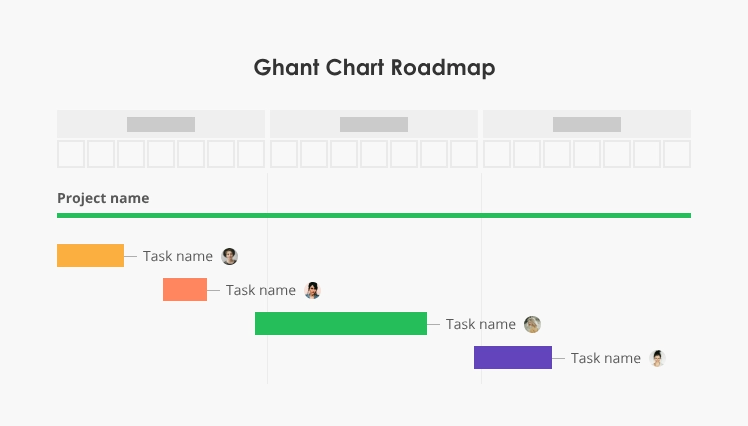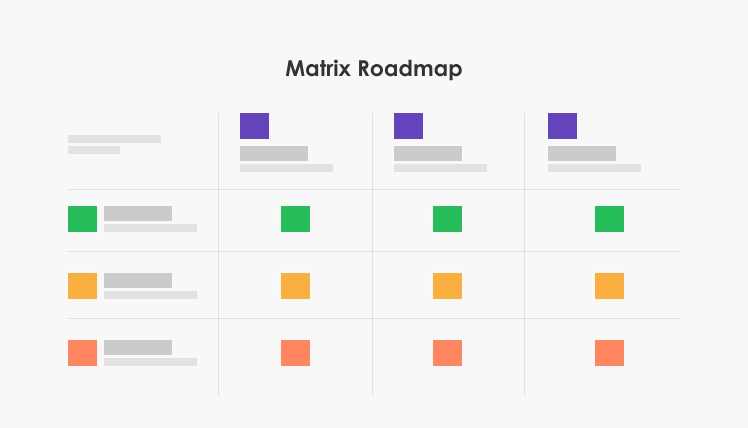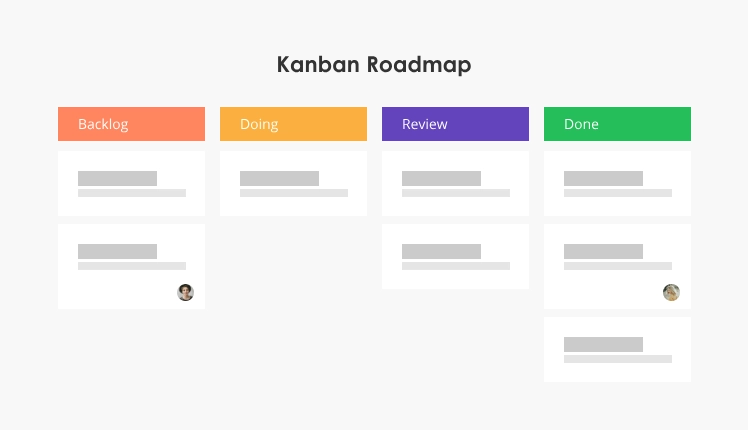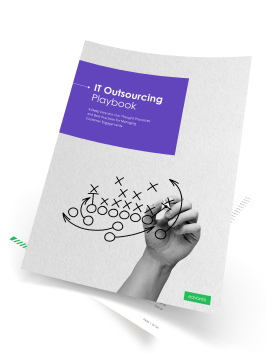Project teams need a single source of truth to boost teamwork and accomplish project objectives. We’ll let the numbers do the talking. Knowledge workers say that access to a single source of truth helps:

Source: Wrike’s 2023 Efficiency Report
It’s a challenge–setting a single source of truth for complex multiphase projects. However, a project roadmap makes it easier. A project roadmap gives you a framework for visualizing critical information and cross-sharing it with your stakeholders, outsourcing vendors, and project teams.
This blog post explains why a project roadmap is vital for managing outsourcing vendor partnerships and provides guidelines on how to create one.
Quick Reminder: What is a Project Roadmap?
Project roadmaps are used to visualize and structure high-level project goals, deliverables, and key milestones. They illustrate how your project scope aligns with your deadlines.
For maximum impact, a project roadmap should be straightforward and visual, communicating only high-level information, and leaving out excessive details.
As the project progresses, you can use components of a project roadmap as reference points on which you can pin project documents such as the project plan, requirements documentation, and a risk register.
Key Components of a Project Roadmap
- Goals and objectives
- Milestones and deliverables
- Tasks and their dependencies
- Task start and end dates
- Assigned people/teams
- Project risks
Does every project need a project roadmap? Not at all. Small and simple projects have fewer phases, consume less time, and require fewer resources. In this case, making a roadmap only wastes time.
For large, complex projects, a roadmap is a must. Here, you balance multiple variables–goals, plans, milestones, and risks. In addition, you manage opposing stakeholder expectations, task dependencies, and time/budget constraints. A project roadmap provides a framework to make sense of this information.
A project roadmap is frequently depicted as a Gantt chart. But if you’re not a fan of timelines and bars, there are project management (PM) tools that depict project roadmaps as tables, boards, and graphs.
Project Roadmap Examples



Project Roadmap vs. Product Roadmap: What are the Differences?
A project roadmap differs from a product roadmap just as much as projects differ from products. The only similarity is their purpose—to be a visual representation of goals.
Product roadmaps describe every stage of the product life cycle: ideation, development, marketing, selling, and phase-out. They include key features, general tasks, and strategic directions along with goals. Your product roadmap will evolve until you stop selling or supporting the software.
Project roadmaps, by contrast, comprise high-level tasks related to a specific aspect of your product (like UI/UX, feature development, testing). That’s why project roadmaps typically have specific end dates and milestones. You do the job–you finish the project–and then you start a new one with its own roadmap.
Project Roadmap vs. Product Roadmap Comparison
| Project Roadmap | Product Roadmap |
| Has set start and end dates | Continues until the product phase-out is complete |
| The focus is on tactical, short-term goals | The focus is on high-level, strategic initiatives |
| Requires day-to-day execution | Requires a future-oriented perspective |
| Aims to deliver a project in scope, on time, and on budget | Aims to achieve business goals |
| Describes project goals and delivery dates | Describes product features and planned release dates |
| Created by a Project Manager; aligned with a specific project team | Crafted by Product Managers and aligned with cross-functional teams |
Benefits of Strong Project Roadmaps for IT Teams
Project roadmaps work for all complex projects, but they are especially useful for managing remote teams and collaborating with outsourcing vendors. Here are a few ways a precisely crafted project roadmap can benefit your outsourcing partnerships:
- Convenient reference point. A project roadmap helps you visualize the important aspects of your project. You can use it during presentations, demos, and meetings to remind participants of the project goals and avoid deviating from the agreed plan.
- Efficient dependency management. The time-bound structure of a roadmap lets you see how project activities interrelate. You can pinpoint intricate dependencies, adjust the scope and timelines, or ask your outsourcing vendor to scale their team appropriately.
- Shared vision for all teams. A project roadmap keeps your in-house, remote, and outsourced teams on track to meet project goals. Having an aligned vision helps them make better decisions that won’t cause bottlenecks down the line (for example, choosing a tech stack that works for all the planned activities or creating an architecture blueprint capable of scaling when more features are added.)
- Improved stakeholder engagement. Project roadmaps prevent workplace miscommunication. Stakeholders use them to monitor work progress, advocate for scope changes, and coordinate strategic activities. You can use roadmaps to notify stakeholders when timelines and budgets are adjusted due to scope changes.
- Better communication with outsourcing vendor partners. With a project roadmap, you can quickly remind your external partners about the business context and strategy. Your vendor can use a roadmap to anticipate changes such as the need for additional services or expertise and make advance preparations.
- Faster onboarding. New team members, stakeholders, and vendors can use a roadmap to quickly grasp the primary project information, gaining a general sense of the project before diving into the details and the associated lengthy documents.
How to Create a Project Roadmap and Share it with Your Teams
Making a project roadmap is part of the planning phase. It is generally the responsibility of both the Project Manager (PM) and key stakeholders. More realistically, though, your PM will develop a roadmap and then present it to stakeholders for approval.
If you are having trouble finalizing your project roadmap, consider requesting a discovery phase from your outsourcing vendor. The discovery phase is the pre-development stage of an IT project, where you clarify your vision, user requirements, and develop a project roadmap with your outsourcing vendor partner.
To create and cross-share a project roadmap, you’ll need to go through these steps:

1. Review Your Project Vision
Every successful product has a clear vision behind it. The Project vision is a statement that summarizes business goals–the “why” behind the project–and how they fit into your overall strategy.
To define a project vision, you’ll ask yourself:
- Why did we initiate this project?
- What problem(s) do we hope to address?
- What value could this project deliver to our customers and users?
- What are the financial and operational risks?
2. Decide on the Key Success Metrics
Identify criteria to determine if your project meets your business goals. Establish these criteria for each project stage, not only for the final result, so that progress can be assessed throughout the duration of the project.
In Agile planning, teams break down the project into sprints, setting specific goals for each one. In Waterfall projects, it’s essential to predetermine the desired business outcomes for each phase.

Based on these general project criteria, you will later create IT performance metrics to measure your team’s performance. Metrics gauge whether your development process is on track and whether your outsourcing service model aligns with your business goals.
3. Define the Main Milestones
Milestones are points on a project roadmap where you measure progress against established success criteria. You can set milestones to mark the beginning or end of your project, major releases in between, or any stage you believe is important.
You may consider marking the following milestones:
- Signing a contract with an outsourcing vendor
- Conducting a project kickoff meeting
- Deciding on the project schedule and budget
- Completing key tasks
- Scaling up a team
- Receiving first feedback from stakeholders
Milestone management relies heavily on software development methodology. The traditional methodology ties milestones to specific dates and is resistant to mid-project changes. In Agile, milestones are more flexible, and can be adapted to each sprint. Agile is the most common route, and the one we recommend at Edvantis.
4. Add Tasks for Each Milestone
Use a Work Breakdown Structure (WBS) to decompose SDLC stages into concrete tasks. Although you will not list the specific tasks in your project roadmap, understanding low-level activities will help refine and fine-tune your project’s high-level structure. The WBS will help you catch bottlenecks proactively, estimate project timelines, and accurately determine a team’s loading and budget.
Here’s how a WBS looks:
To populate a WBS, follow these steps:
- Decompose large deliverables into smaller work packages, and break packages down into smaller activities.
- Set clear boundaries for each phase, work package, and activity.
- Identify those responsible and accountable for each work package and activity.
- List all details within the activity, and if necessary, break steps down into sub-tasks.
5. Estimate Your Project Timeline
Once you have identified all the activities included in your project, estimate the duration of each activity stage. At this point, you can involve both in-house and outsourcing teams. With hands-on experience, they can make more realistic estimates, recognizing that designing, coding, and testing are not the only aspects of a task. It is important to set aside time for research, communication, review, and unforeseen circumstances.
Traditionally, software teams give estimations based on timeframes: days, weeks, and months. However, there are many other ways to estimate project timelines, such as:
- Story points are Agile measurements that indicate the amount of effort (rather than time) required to fully implement a product backlog item using relative values. Team members determine how much effort it takes to complete a one story-point task. This value will be a reference point for other estimations.
- A bucket system is an estimation method where numbered sticky notes are sequentially placed on a wall or table. Each sticky note represents a task to be estimated. Bucket numbers are a modified fibonacci sequence and normally range from 0-200 (0, 1, 2, 3, 4, 5, 8, 13, 20, 30, 50, 100, and 200). The team discusses every task (sticky note) and assigns each to a specific bucket. Let’s say, the simplest task in your backlog will go to a bucket 2 and the most difficult one – to 100. This technique works best for estimating large product backlog items.
- Dot voting is a prioritization process where each team member receives a few dots (stickers) and votes for a specific estimate. The estimate with the most votes is deemed to be the correct estimate.
6. Finalize and Share Your Project Roadmap
After following this development process, you will have all the necessary input for your project roadmap: vision, goals, success criteria, milestones, and a schedule. Before creating a project roadmap, conduct a final round of task prioritization and cross-check dependencies. Make changes if you detect inconsistencies.
Next, enter your project information into a specialized PM tool that will generate a ready-made project roadmap (see below). You can further edit the roadmap and extract it in different formats. Many apps also offer additional functionality for task monitoring and time tracking, with built-in progress analytics.

Finally, share the project roadmap with everyone. Here are a few tips on how to keep your project roadmap productive:
- Share it with in-house and outsourced teams.
- Make sure everyone knows where the roadmap is located so they can refer to it anytime.
- Host regular team meetings to review the roadmap
- Update the document as scope/time/budget changes occur.
Conclusion
According to Asana’s 2023 Report, organizations that set clear and connected goals are more likely to fulfill customer needs (87% of respondents), sustain revenue growth (75%), and gain a competitive edge (73%). With a roadmap, you have a powerful tool to achieve these benefits.
Project roadmaps will keep your teams, stakeholders, and sponsors aligned with business goals. Moreover, they will provide a sense of direction to your outsourcing vendor relationship.
Are you considering starting a project but need help refining a project vision and roadmap? Let’s schedule a discovery meeting!


